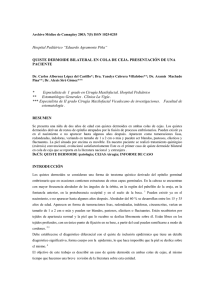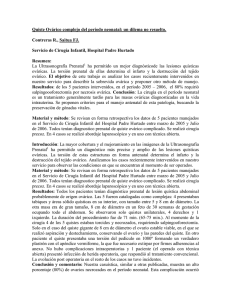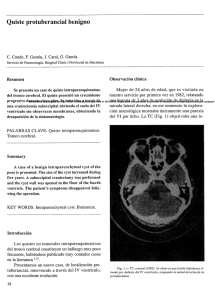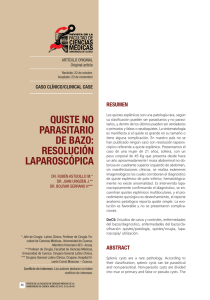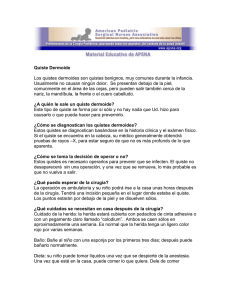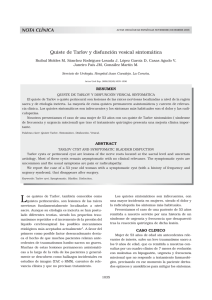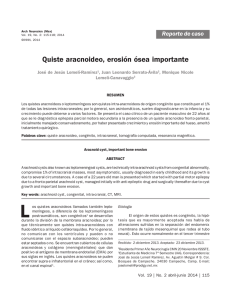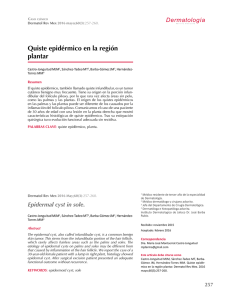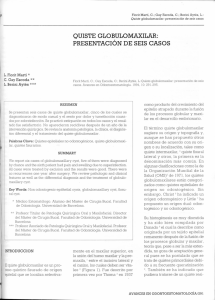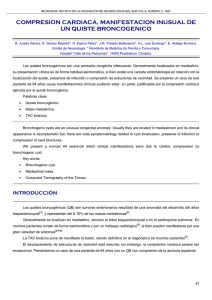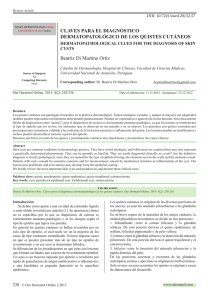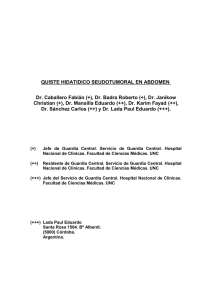Quiste Sinoviales o Gangliones
Anuncio
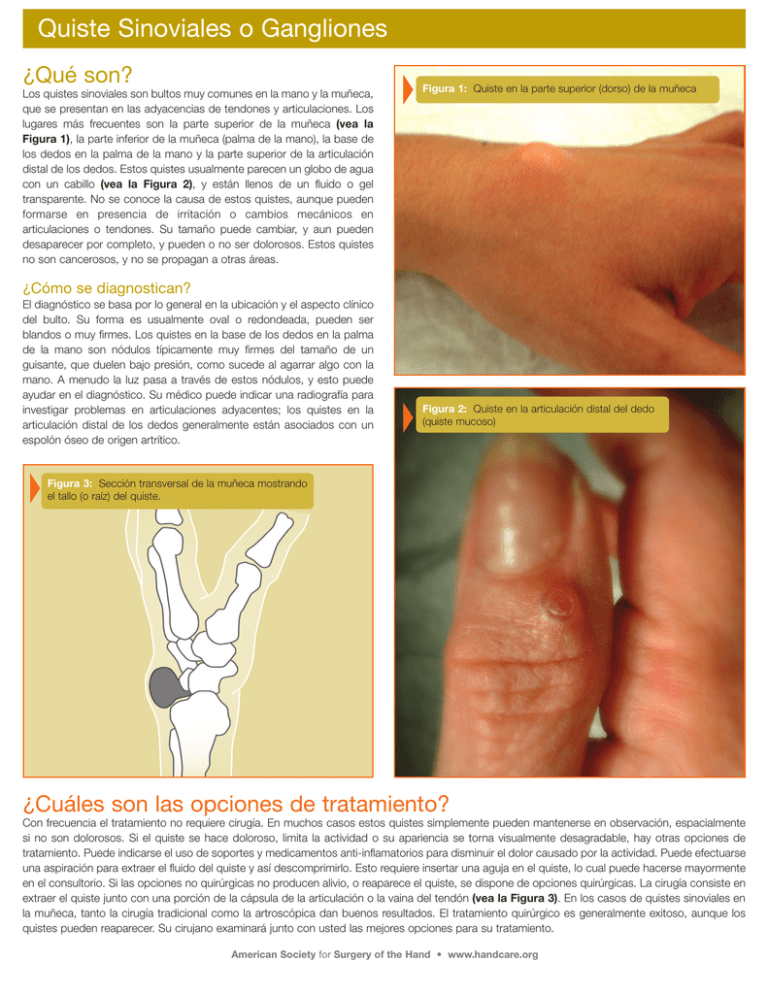
Quiste Sinoviales o Gangliones ¿Qué son? Los quistes sinoviales son bultos muy comunes en la mano y la muñeca, que se presentan en las adyacencias de tendones y articulaciones. Los lugares más frecuentes son la parte superior de la muñeca (vea la Figura 1), la parte inferior de la muñeca (palma de la mano), la base de los dedos en la palma de la mano y la parte superior de la articulación distal de los dedos. Estos quistes usualmente parecen un globo de agua con un cabillo (vea la Figura 2), y están llenos de un fluido o gel transparente. No se conoce la causa de estos quistes, aunque pueden formarse en presencia de irritación o cambios mecánicos en articulaciones o tendones. Su tamaño puede cambiar, y aun pueden desaparecer por completo, y pueden o no ser dolorosos. Estos quistes no son cancerosos, y no se propagan a otras áreas. Figura 1: Quiste en la parte superior (dorso) de la muñeca ¿Cómo se diagnostican? El diagnóstico se basa por lo general en la ubicación y el aspecto clínico del bulto. Su forma es usualmente oval o redondeada, pueden ser blandos o muy firmes. Los quistes en la base de los dedos en la palma de la mano son nódulos típicamente muy firmes del tamaño de un guisante, que duelen bajo presión, como sucede al agarrar algo con la mano. A menudo la luz pasa a través de estos nódulos, y esto puede ayudar en el diagnóstico. Su médico puede indicar una radiografía para investigar problemas en articulaciones adyacentes; los quistes en la articulación distal de los dedos generalmente están asociados con un espolón óseo de origen artrítico. Figura 2: Quiste en la articulación distal del dedo (quiste mucoso) Figura 3: Sección transversal de la muñeca mostrando el tallo (o raíz) del quiste. ¿Cuáles son las opciones de tratamiento? Con frecuencia el tratamiento no requiere cirugía. En muchos casos estos quistes simplemente pueden mantenerse en observación, espacialmente si no son dolorosos. Si el quiste se hace doloroso, limita la actividad o su apariencia se torna visualmente desagradable, hay otras opciones de tratamiento. Puede indicarse el uso de soportes y medicamentos anti-inflamatorios para disminuir el dolor causado por la actividad. Puede efectuarse una aspiración para extraer el fluido del quiste y así descomprimirlo. Esto requiere insertar una aguja en el quiste, lo cual puede hacerse mayormente en el consultorio. Si las opciones no quirúrgicas no producen alivio, o reaparece el quiste, se dispone de opciones quirúrgicas. La cirugía consiste en extraer el quiste junto con una porción de la cápsula de la articulación o la vaina del tendón (vea la Figura 3). En los casos de quistes sinoviales en la muñeca, tanto la cirugía tradicional como la artroscópica dan buenos resultados. El tratamiento quirúrgico es generalmente exitoso, aunque los quistes pueden reaparecer. Su cirujano examinará junto con usted las mejores opciones para su tratamiento. American Society for Surgery of the Hand • www.handcare.org Ganglion Cysts What are they? Ganglion cysts are very common lumps within the hand and wrist that occur adjacent to joints or tendons. The most common locations are the top of the wrist (see Figure 1), the palm side of the wrist, the base of the finger on the palm side, and the top of the end joint of the finger (see Figure 2). The ganglion cyst often resembles a water balloon on a stalk (see Figure 3), and is filled with clear fluid or gel. The cause of these cysts is unknown although they may form in the presence of joint or tendon irritation or mechanical changes. They occur in patients of all ages. Figure 2: Ganglion end joint of finger (mucous cyst) These cysts may change in size or even disappear completely, and they may or may not be painful. These cysts are not cancerous and will not spread to other areas. Figure 1: Ganglion top side (dorsum) wrist Figure 3: Cross section of wrist showing stalk (or root) of ganglion. How are they diagnosed? The diagnosis is usually based on the location of the lump and its appearance. They are usually oval or round and may be soft or very firm. Cysts at the base of the finger on the palm side are typically very firm, pea sized nodules that are tender to applied pressure, such as when gripping. Light will often pass through these lumps, (transillumination) and this can assist in the diagnosis. Your physician may request x rays in order to investigate problems in adjacent joints. Cysts at the end joint of the finger frequently have an arthritic bone spur associated with them. What are the treatment options? Treatment can often be non-surgical. In many cases, these cysts can simply be observed, especially if they are painless, as they frequently disappear spontaneously. If the cyst becomes painful, limits activity, or is otherwise unacceptable, several treatment options are available. The use of splints and anti-inflammatory medication can be prescribed in order to decrease pain associated with activities. An aspiration can be performed to remove the fluid from the cyst and decompress it. This requires placing a needle into the cyst, which can be performed in most office settings. Aspiration is a very simple procedure, but recurrence of the cyst is common. If non-surgical options fail to provide relief or if the cyst recurs, surgical alternatives are available. Surgery involves removing the cyst along with a portion of the joint capsule or tendon sheath (see Figure 3). In the case of wrist ganglion cysts, both traditional open and arthroscopic techniques usually yield good results. Surgical treatment is generally successful although cysts may recur. Your surgeon will discuss the best treatment options for you. "NFSJDBO4PDJFUZGPS4VSHFSZPGUIF)BOEtXXXIBOEDBSFPSH
